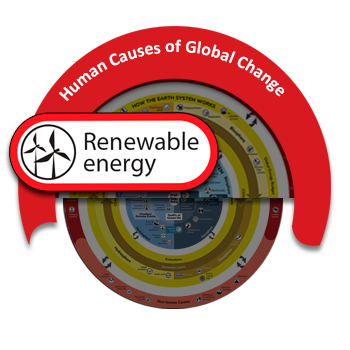Renewable energy is energy generated using resources that can be regenerated over relatively short timescales (months to years), or when resources are not consumed during the energy-generating process. Solar, wind, biofuel, hydropower, and geothermal energy are examples of renewable energy sources. Innovation and development of renewable energy sources are essential to sustain modern life, which requires large amounts of energy to generate electricity, and to power transportation (for example, cars and planes) and industrial processes. Currently fossil fuels are our primary source of energy, but also cause climate change, alter the Earth’s ecosystems, and cause human and environmental health problems.

A solar farm and wind farm. Credits: Brookhaven National Lab (left); US Department of Energy (right)
The use of renewable energy affects the Earth system in a variety of ways, including:
- Reducing the use of fossil fuels, which in turn decreases the amount of greenhouse gases we generate, such as carbon dioxide (CO2) and nitrous oxide (N2O), that increase the Earth’s average air temperatures. Reducing CO2 emissions will also reduce ocean acidification.
- Reducing pollutants from fossil fuels that reduce air and water quality and harm life, especially sulfur dioxide, nitrogen oxides, and airborne particles such as soot. Poor air and water quality can cause disease.
- Helping to reduce the frequency of acid rain. Sulfur dioxide (SO2), nitrogen oxides (NOx), and carbon dioxide (CO2) from the burning of fossil fuels react with water vapor, oxygen, and other chemicals to form acid rain. Acid rain can contaminate freshwater sources, resulting in harmful algal blooms that reduce water oxygen levels and harm fish populations and other wildlife. Additionally, acid rain increases chemical weathering of rocks, including man-made structures.
Can you think of additional cause and effect relationships between the renewable energy and other parts of the Earth system?
Visit the burning of fossil fuels, agricultural activities, and urbanization pages to learn more about how human activities affect global climate and ecosystems.
Investigate
Learn more in these real-world examples, and challenge yourself to construct a model that explains the Earth system relationships.
Links to Learn More
- U.S. Electricity Generation by Type, from the U.S. EIA (U.S. Energy Information Administration)
- U.S. Energy Information Administration, for up-to-date information about projected energy sources, uses, and flows, go to the
- EIA’s International Energy Outlook
